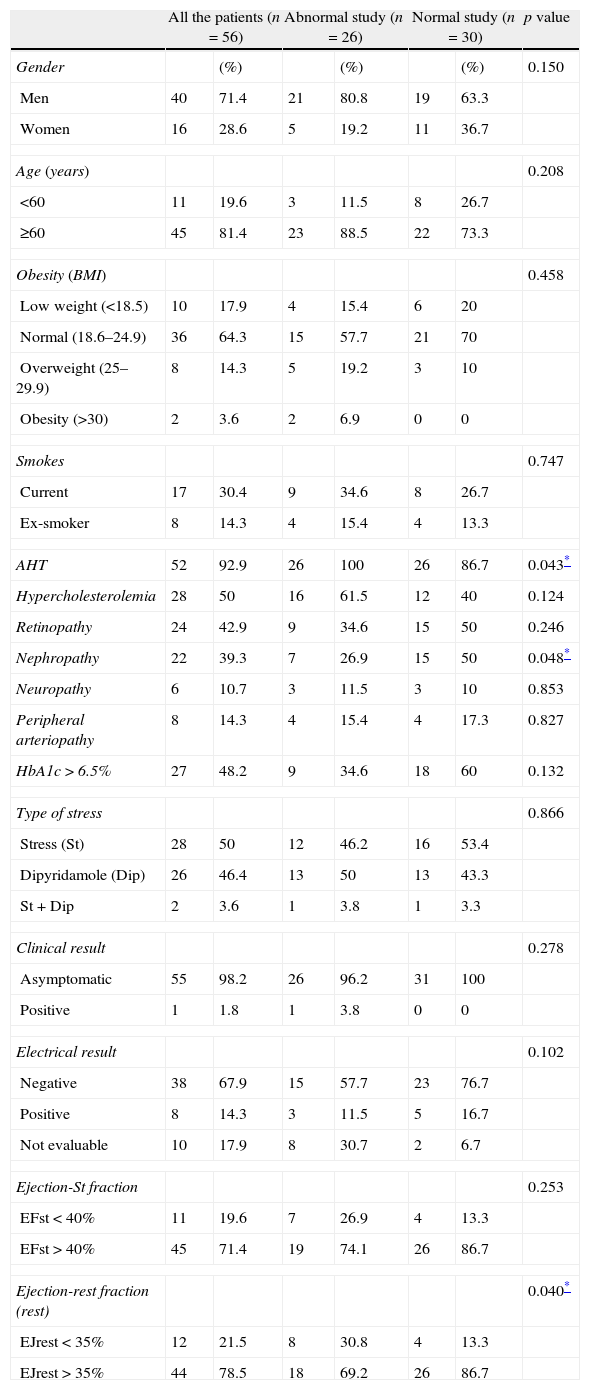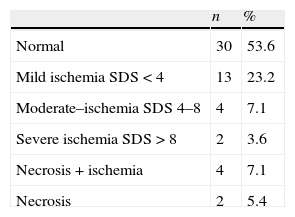To determine the clinical utility of the gated myocardial perfusion SPECT to detect silent ischemia in asymptomatic diabetic patients without previous coronary events and to evaluate the prognosis of this population.
Material and methodsA retrospective study of 56 asymptomatic diabetics referred for a gated myocardial perfusion SPECT for the diagnosis of ischemic disease was performed. The criteria for ischemia were: mild SDS<4, moderate SDS 4–8, severe SDS>8. A multivariable statistical analysis was carried out to identify possible predictive variables of an abnormal SPECT. The cardiovascular events were recorded up to December-2010.
ResultsA high proportion of the 56 patients had an abnormal perfusion study (46.4%), there being moderate–severe ischemia in 10.7%, necrosis with ischemia in 5.4% and necrosis in 7.1%. We found no statistical differences in the type of stress used (treadmill or dipyridamole). The patients had a high combination of cardiovascular risk factors. In the multivariate analysis, diabetic nephropathy was the only factor related to an abnormal SPECT (p=0.043). The events recorded in the follow-up were: 2 early revascularizations, 5 cardiology admissions, 10 non-cardiac related deaths. The existence of ischemia in the SPECT was significantly related to the appearance of cardiovascular events (p<0.05).
ConclusionA gated myocardial perfusion SPECT in asymptomatic diabetics with high combination of cardiovascular risk factors detects silent ischemia in a significant proportion and this seems to be related to future coronary events. Diabetic nephropathy implies a greater likelihood of abnormal studies. However, the screening criteria in this population still need to be established for better performance and lower cost.
Determinar la utilidad clínica de la gated-SPECT de perfusión miocárdica en la detección de isquemia silente en pacientes diabéticos sin síntomas ni eventos cardiovasculares previos y evaluar implicaciones pronósticas.
Material y métodosEstudio retrospectivo de 56 pacientes diabéticos asintomáticos tras una gated-SPECT de perfusión miocárdica para diagnóstico de enfermedad isquémica. El criterio de isquemia fue: ligera SDS<4, moderada SDS de 4 a 8, severa SDS>8. Se realizó un análisis estadístico multivariante para identificar variables predictoras de un estudio anormal y se registraron hasta diciembre de 2010 los eventos cardiovasculares.
ResultadosUna alta proporción de los 56 pacientes presentó un estudio de perfusión anormal (46,4%), existiendo isquemia moderada-severa en el 10,7%, necrosis con isquemia en el 5,4% y necrosis en el 7,1%. No encontramos diferencias en cuanto al tipo de esfuerzo (tapiz rodante o dipiridamol). Existió una alta combinación de factores de riesgo cardiovascular. En el análisis multivariante, la nefropatía diabética fue la única que se relacionó con una SPECT anormal (p=0,043). En el seguimiento, los eventos fueron: 2 revascularizaciones precoces, 5 ingresos en cardiología, 10 muertes de no origen cardíaco. La existencia de isquemia en la SPECT se relacionó de forma significativa con la aparición de eventos cardiovasculares (p<0,05).
ConclusiónLa SPECT de perfusión miocárdica en diabéticos asintomáticos con alta asociación de factores de riesgo detecta la existencia de isquemia silente, la cual parece relacionarse con futuros eventos cardiovasculares. La nefropatía diabética sugiere mayor probabilidad de estudios anormales; sin embargo, es preciso establecer los criterios de cribado para un mayor rendimiento y un menor coste económico.
Article
If you experience access problems, you can contact the SEMNIM Technical Secretariat by email at secretaria.tecnica@semnim.es or by phone at +34 619 594 780.

Revista Española de Medicina Nuclear e Imagen Molecular (English Edition)








